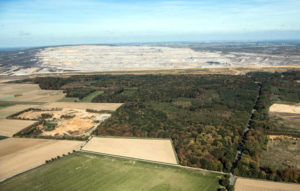Hambacher Forst, called ‘Hambi’ by many, is a 200 hectare-forest turned into the symbol of resistance of the anti-coal-fired power generation in Germany. Situated in the middle of German’s Rhenish coal mining areas it harbours trees in excess of 300 years of age, represents one of Europe’s last “pristine” forests and several protected species but is, too, a major obstacle to the enlargement of the coal mining area.
Despite the political decision to exit power generation from brown coal there is currently no obvious sign of a retreat in coal-fired power generation and its circumstances. North Rhine-Westphalia Germany holds highly polluting power stations emitting millions of tons of CO2. Currently, the coal industry employs hardly 20.000 and fights for sinecure and survival and argues abandoning coal causes unemployment and poverty to the employed and their families.
It cannot be, we always consider business more valuable than any other. So, chopping the trees simply in the industry’s interest is unacceptable. Change means change, and in times of climate change and the future of humanity, we need to take rough decisions. Even if that means redundancy to the 20.000 in the first instance. Burning of fossil fuels is a dead-end anyway, abandoning coal seems without option to start with.
But I would like to turn the argument towards some other aspects. I may be called “simplistic”, but the necessary change won’t come, if we don’t start:
The potential redundancy to the 20.000 is deplorable and finding new jobs is difficult as 50% of the coal-based workforce is aged 50 years or older. When Schlecker, a German chain store going bankrupt a few years ago, Half of the 25.000 ‘Schlecker-Ladies’ with almost same characteristics found a new job or official occupation during 1styear, others registered unemployed or turned self-employed (1% only). Obviously, it caused havoc and financial issues, but Germany offers welfare, redundancy programs and much more to soften such hardship. I understand the problems on the individual level and accept, what seems whatever in the bigger picture does not necessarily mean beneficial for every individual.
Despite my refusal to agree cutting the Hambi- trees, more important the hypocrisy of the “tree huggers”. It is/was Christmas again and know what? 30 million Christmas trees were chopped, mounted at home for decoration’s sake and then thrown away. 30 million! Any objection here? Negative. How many of the demonstrators had a Christmas tree at home?
The German area under cultivation for Christmas trees amounts to 50.000 hectares of which app. 10% needs to be cut for just these 30 million. That is 5.000 hectares, compared to the 200 of the ‘Hambi’. Acceptedly, these figures I figured myself, but even if I was mistaking, and we consider 10% of my numbers, we still talk 500 hectares cut, EACH YEAR, year on year.
Accepted, 200 hectares cultivated by Christmas trees produces much less oxygen for countering CO2-emission as the Hambi does, and the Hambi-trees with their age compared to the average age of 9 years to a Christmas tree does argue a right of different appreciation, but either you are a tree hugger or not. And yes, cultivating Christmas trees is pollution by chemicals and fertilizers. But is it Christmas trees are less worth to consider? Are tree-huggers tree-racists alike?
Plastic trees are obviously no option either, but there must be a solution: this year was my last with a chopped tree. Next year I shall opt for a tree in a pot with roots. I may add each year another tree in my garden or keep it in its pot for the next years to come and reuse it. But I want the Hambi to survive and remain as I want to stop chopping up 30 million trees each for tradition’s sake and to be thrown away. This is neither sustainable, and we need sustainability.
However, and again, I am against chopping down the Hambi, but I refuse the dishonest and ambiguous hypocrisy of the anti-coal community, too.



